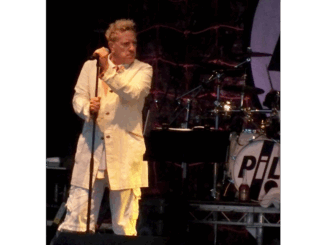This is the second book by this author to be reviewed on GP – you can find my review of his previous novel, Three Lives (linky). Written with both heart and head, The Blue House is a novel of action and psychological development, with a dash of Boys’ Own adventure thrown in. We start with an intriguing cameo of the protagonist in bed in a beautiful Alpine setting. Hotel? Chalet? Clinic? It’s not immediately clear – and we must wait to find out, while the background gets filled in.
It’s 1982, and Tony is on a quest … he just doesn’t know what for, yet. Is he running away (from a failed relationship and his previous life) … or running towards (in which case, towards what)? His life begins to resemble a travelogue, as he works on a farm in an idyllic setting in Brazil, owned by someone called Roberto. This part of the book has a filmic quality, with some arresting and very atmospheric descriptions of the scenery and wildlife on the ranch next to its spectacular waterfall – one of the few places Tony finds peace and some spiritual consolation. Inevitably, this mini-paradise is disrupted by disaster – a fire, a shoot-out and a murder ensue. Tony flees to Bolivia, then Colombia. He goes trekking, sets up a fish farming enterprise, decamps to South Africa, works for a Nigerian oil business, goes to Australia, Qatar, India, Kathmandu, Thailand, Malaysia, Singapore and Chile, then tours Britain in a motor home before finding somewhere he can finally settle. But settling down in Blighty and reconnecting with his old friends can bring problems of its own …
By this point I was getting a bit dizzy – which is not to say I wasn’t still enjoying it, but the pace was becoming a bit hectic, leading me to wonder if the story, while crisply and punchily written, might not have benefitted from actually being a bit longer: this is a fairly short book, and there is enough material for several hundred pages if developed a bit further. Each location and its contribution to Tony’s journey (both physical and mental) could perhaps have been explored more in depth. However, the book cracks on, and the character development really picks up in the last third or so. It is the story of a man struggling to find his place in the world, and whatever meaning he can along the way. The occasional interweaving of political commentary and the addition of observations about current affairs which are introduced not only add a sense of placing Tony and the other characters in context but also act also as a sort of historical record. Many interesting aperçus, statistics and observations about the times are contained here which could otherwise easily have been forgotten. At times, these passages almost read like extracts from someone’s journal. And eventually, Tony – while bruised and buffeted by fate – recovers his will to live as a result of a very personal (what might even be described as Puffinesque!) incident.
In a way, it’s a bit like the picaresque novels of the 18th and 19th century – not in its language, which is bang up to date, but in its structure: an episodic recounting of the adventures of an anti-hero living by his wits while on the road. I particularly liked the way the author, at the end, brought us back to the beginning. It gave a satisfying circularity to the narrative. The actual ending itself is rather beautiful.
All in all, an enjoyable romp through one man’s life which made me wonder if it was in some ways a roman à clef (a novel in which incidents are taken from real life). If so, judging by where Tony finally ends up, I would say he is one lucky man.
© foxoles 2025



